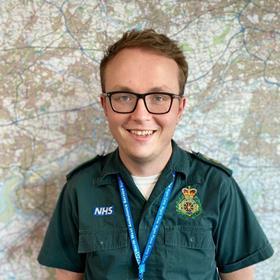Matt Dugdale, head of digital and clinical innovation at North West Ambulance Service Trust, shares how the trust is using technology to improve ambulance services

There’s a technological revolution happening in a remote corner of the country, which may well mark the start of the next chapter of the UK’s ambulance services. We caught up with Matt Dugdale, head of digital and clinical innovation at North West Ambulance Service Trust, to find out more.
After starting his career as a paramedic nine years ago, Matt now works in the NWAS urgent care development team testing and developing new ideas for the benefit of patients and clinicians.
From your perspective, what are the biggest challenges facing paramedics today?
The whole NHS is dealing with increased demand for its services. As paramedics, we see the impact of this when it takes longer to handover at busy hospitals. We want to be back out responding to waiting patients, and whenever possible, providing the right care to people in the community so they can avoid a trip to hospital if they don’t need to be there.
We see lots of opportunities for technology to help the NHS make services more efficient, freeing up more time for healthcare professionals to care for patients.
Historically, we might have rolled out new tech because it felt like the right thing to do, or there was a bit of budget left at the end of the year. Instead, today we’re co-designing solutions with staff to fit a problem or challenge.
For instance, point-of-care testing is something we’re exploring with the smart ambulance pilot. Rather than going to a hospital for patient diagnostic tests, paramedics conduct them on the scene or in the ambulance – before taking the patient to the most appropriate place for their care. It’s about ensuring we’re using technology to deliver meaningful interventions that benefit both staff and our patients.
Tell us about the smart interactive wallboards and smart lighting that have been rolled out at Kendal Ambulance Station. How did this project come about?
It started from a staff idea to have a digital notice board, which would display any required vehicle and equipment checks. However, my brain always wants to go away and see what else is possible. So, rather than simply roll out smart interactive wallboards across the organisation, we agreed to establish smart technology pilot sites and an incubator site “off-grid” away from our central headquarters.
And because of the geographical spread of our organisation, we were able to engage a team that had previously missed out on some of our quality improvement work. Working this way has also let us identify new ideas and opportunities, such as Power over Ethernet lighting (PoE).
PoE is a method of transmitting electrical power through ethernet cables, so devices can be networked and powered by the same cables.
The circadian LED lighting improves staff wellbeing, but is also better for the environment and our energy costs – generating a whopping 90 per cent improvement in efficiency and a lighting energy and carbon footprint saving of 70 per cent.
There are definite advantages to innovating in a remote area. We wanted to prove that if it can work in the middle of Cumbria there’s no reason why it won’t work in Central Manchester.
The approach has given us the time and breathing space to collaborate directly with staff on the ground, working together to develop the best fit for their needs.
We’re working in partnership with The Lister Alliance, a consortium of NHS trusts, practitioners, industry and academia committed to reshaping the future of healthcare for patients with a bottom-up approach to innovation.
You have to bring people along on the journey with you. Innovation in isolation goes nowhere
This partnership has allowed us to customise the vehicle, testing and rapidly iterating elements to get the best outcome. So, if a staff member says something doesn’t work, then it’s no problem: we can try a different approach to get it right.
What do you think are the biggest barriers to innovation in the NHS?
Funding is always a challenge. For the wider health service, it’s an issue of recognising the investment that’s needed to generate the output, as well as the money to scale a solution out.
Technological innovation is seen as something that is “fairly new”. There’s no formal training – I learned our approach and was guided by others inside and outside our organisation.
Another challenge is ensuring people across the organisation are aligned with what you’re trying to achieve. People will often come with ideas, but they don’t necessarily think you’ll be able to make it happen.
That’s where co-design and co-creation are important. While they come across as buzzwords, it’s where you get the added value and buy-in from service leads and frontline staff so they can be the ones to drive things forward. You have to bring people along on the journey with you. Innovation in isolation goes nowhere.
Tell us how the smart ambulance came about.
The smart ambulance is the other side of our programme in Kendal. We’re working closely with staff to understand problems in their day-to-day work and the challenges they might face in the back of an ambulance.
The layout of the vehicle hasn’t changed in the last 10 years. And while some equipment may have gotten lighter, staff still experience problems. It’s been identified that remote access to clinical support would benefit outcomes, for example. We’re working through those problems to think of a solution that doesn’t cost the earth and is easily scaled.
With Cisco and the Lister Alliance, we’re looking to test the concept of a “modular” approach to a new smart ambulance, enabling NWAS to consider its benefits. It could be voice control in the back or managing access to controlled drugs, for instance. This approach removes the need for expensive new vehicles; instead, it creates the potential to retrofit the ambulances on the roads today.
What are the next steps for the project?
We’re using the work in Kendal as a blueprint for other trusts after winning funding from NHS England’s Future Connectivity programme. We’re focussing on LiFi technology, where internet connectivity is transmitted through lighting. We’ve also won funding from the NHS England clinical entrepreneurship programme to look at how commercial partnerships can help solve challenges. And we’ll continue to work closely with staff to ensure innovation is designed to meet the needs of those it will actually impact.
For readers wanting to find out more, where can they go?
Visit the Lister Alliance website to learn more and get involved.



























